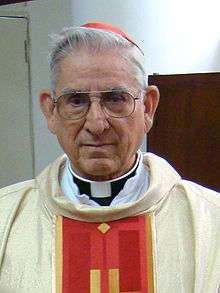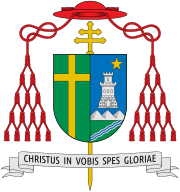Darío Castrillón Hoyos
| His Eminence Darío Castrillón Hoyos | |
|---|---|
| Prefect Emeritus of the Congregation for the Clergy | |
 | |
| Appointed | 15 June 1996 |
| Term ended | 31 October 2006 |
| Predecessor | Jose Tomas Sanchez |
| Successor | Cláudio Hummes |
| Other posts | Cardinal-Priest of SS. Nome di Maria al Foro Traiano |
| Orders | |
| Ordination |
26 October 1952 by Alfonso Carinci |
| Consecration |
18 July 1971 by Ángelo Palmas |
| Created Cardinal |
21 February 1998 by Pope John Paul II |
| Rank | Cardinal-Priest |
| Personal details | |
| Born |
4 July 1929 Medellín, Colombia |
| Nationality | Colombian |
| Denomination | Roman Catholic |
| Previous post |
|
| Motto | Christus in vobis spes gloriae |
| Coat of arms |
 |
Darío del Niño Jesús Castrillón Hoyos (born 4 July 1929) is a Colombian cardinal of the Catholic Church. He was Prefect of the Congregation for the Clergy from 1996 to 2006, and is the president emeritus of the Pontifical Commission Ecclesia Dei having served from 2000 until his retirement in 2009. He was elevated to the cardinalate in 1998.
Early life
Born in Medellín, Colombia, Castrillón Hoyos attended the seminaries in Antioquia and Santa Rosa de Osos before going to Rome to study at the Pontifical Gregorian University. He was ordained to the priesthood by Archbishop Alfonso Carinci on 26 October 1952, in the basilica of Ss. XII Apostoli. He finished his studies at the Gregorian, from where he obtained a doctorate in canon law and specialization in religious sociology, political economics, and ethical economics. Castrillón Hoyos also studied at the Sociology Faculty of the University of Louvain in Belgium.
Upon returning to Colombia, he served as a curate for two rural parishes in Yarumal from 1954 to 1971. He then served as director of Cursillos, of the national pastoral program, and of the Legion of Mary. After becoming an official in the diocesan curia of Santa Rosa de Osos, Castrillón was made director of radiophonic schools. In 1959 he became the diocesan delegate of Catholic Action, and also worked as ecclesiastical assistant to the Catholic Workers Youth. He did catechetical and curial work before serving as general secretary of the Colombian Episcopal Conference.
Bishop
On 2 June 1971, Castrillón Hoyos was appointed Coadjutor bishop of Pereira and Titular bishop of Villa Regis by Pope Paul VI. He received his episcopal consecration on the following 18 July from Archbishop Ángelo Palmas, with Archbishop Aníbal Muñoz Duque and Bishop Baltasar Álvarez Restrepo serving as co-consecrators. Castrillón Hoyos succeeded Alvarez Restrepo as Bishop of Pereira on 1 July 1976.
During his time as Bishop of Pereira, Castrillón Hoyos was reported to have walked the streets at night to help feed abandoned children.[1] While many Latin American bishops refused to accept contributions from suspected drug lords, Castrillón Hoyos accepted donations for his diocese's charities, arguing that by accepting the funds, they would be diverted from funding crime and instead used to help the poor and needy. He said that when accepting such donations, he had warned the donors personally that their donations "would not save their souls".[1] Castrillón Hoyos once disguised himself as a milkman to gain access to the home of drug lord Pablo Escobar, and after revealing himself, the bishop successfully persuaded Escobar to confess his sins.[1][2] Castrillón Hoyos also served as Secretary General (1983–1987) and then president (1987–1991) of the Latin American Episcopal Conference, where he took a hard line stance opposing liberation theology, which was popular among leftist Latin American bishops at that time.
Castrillón Hoyos was advanced to Archbishop of Bucaramanga on 16 December 1991. He remained in that post until 15 June 1996, when he became Pro-Prefect of the Congregation for the Clergy in the Roman Curia. In this capacity, he was responsible for the celebrations commemorating the 50th anniversary of Pope John Paul II's priestly ordination that November.
| Styles of Darío Castrillón Hoyos | |
|---|---|
 | |
| Reference style | His Eminence |
| Spoken style | Your Eminence |
| Informal style | Cardinal |
| See | Bucaramanga (Emeritus) |
Cardinal
John Paul II created him Cardinal-Deacon of SS. Nome di Maria al Foro Traiano in the consistory of 21 February 1998. Two days later, on 23 February, Castrillón Hoyos was promoted to full Prefect of the Congregation for Clergy. On 26 October of that same year he served as papal envoy to the signing of the peace accord between Peru and Ecuador to settle their border dispute.
On 14 April 2000, he replaced Angelo Felici as President of the Pontifical Commission Ecclesia Dei, the Curial office that handles the Vatican's relations with Traditionalist groups such as the Society of St. Pius X.
Castrillón was appointed Grand Prior of the Constantinian Order of St George by Infante Carlos, Duke of Calabria, on 27 February 2004.
Following the death of John Paul II, Castrillón participated in the 2005 papal conclave and was himself considered papabile - a possible successor to the papacy. The new Pope Benedict XVI confirmed him as Prefect of the Congregation for the Clergy and President of the Pontifical Commission Ecclesia Dei.
On 31 October 2006, the Cardinal resigned as head of the Congregation for the Clergy, but remained as President of Ecclesia Dei. On 27 June 2007, Castrillón attended a briefing at the Apostolic Palace on Pope Benedict's impending motu proprio granting greater accessinility to the Tridentine Mass.[3] On 13 September 2007 Cardinal Castrillón Hoyos was interviewed by Vatican Radio about the implementation of Pope Benedict's motu proprio, Summorum Pontificum.[4]
In May 2007 Castrillón participated in the general conference of the Latin American Episcopal Conference, also attended by Pope Benedict, in Brazil.
On 23 February 2007, Castrillón became Protodeacon, the senior Cardinal-Deacon, which he remained until 1 March 2008, when he was elevated to Cardinal-Priest. His titular deaconry Ss. Nominis Mariae ad forum Traiani (Italian: Santissimo Nome di Maria al Foro Traiano) was elevated pro hac vice to title. Hoyos' successor as Cardinal protodeacon was Agostino Cacciavillan.
Retirement
Cardinal Castrillón Hoyos retired on 8 July 2009. On the same day, Pope Benedict issued the motu proprio Ecclesiae Unitatem, which attached the Pontifical Commission Ecclesia Dei to the Congregation for the Doctrine of the Faith. As a result of the motu proprio, William Levada, the Prefect of the Congregation for the Doctrine of the Faith, became ex officio the President of the Pontifical Commission Ecclesia Dei.[5]
Cardinal Castrillón Hoyos told the German newspaper Süddeutsche Zeitung that it was a "calumny" to say that he had been informed of Richard Williamson's negationist views, in response to allegations by Bishop Anders Arborelius of Stockholm that the Holy See had prior knowledge of the controversy. He has argued that if anyone in the Vatican should have known about the matter, it was not himself but rather Cardinal Giovanni Battista Re, due to the fact that Re is Prefect of the Congregation of Bishops, which is responsible for matters relating to non-missionary Latin-Rite ordinaries.[6][7]
Handling of sexual abuse cases
Cardinal Castrillón Hoyos has come under criticism for his handling of cases of sexual abuse inside the Church as prefect of the Congregation for the Clergy.
In 2002, Castrillón expressed his disapproval of the zero-tolerance policy of the U.S. bishops towards cases of sexual abuse, saying that the bishops ignored such "fundamental principles of the Church" as forgiveness and conversion.[8]
In 2010, it was revealed that Castrillón had congratulated French bishop Pierre Pican in a 2001 letter for not denouncing a priest who had engaged in sexual abuse of minors and was later sentenced to 18 years in jail. Bishop Pican himself received a suspended three-month jail sentence for not denouncing the priest.[9] In the letter Castrillón described the relationship between a bishop and his priests as "not professional but a sacramental relationship which forges very special bonds of spiritual paternity" and continued "The bishop has other means of acting [...] but a bishop cannot be required to make the denunciation himself. In all civilised legal systems it is acknowledged that close relations have the possibility of not testifying against a direct relative."[10] The letter also cited the Apostle Paul (Phil 1:13–14) to bolster its argument.
Vatican spokesman Federico Lombardi did not dispute the letter's authenticity, but said it confirmed "how opportune it was to centralize treatment of Catholic sex abuse cases by clerics under the Congregation for the Doctrine of the Faith."[11]
In 2011, a documentary aired by the Irish television network RTÉ,[12] revealed disagreements between Castrillón and the Irish bishops on the proper treatment of priests accused of sex abuse. In 1997, Castrillón expressed to the Irish bishops reservations about proposals discussed by the bishops at the time.[13] While indicating that his Congregation was still studying the question, Castrillón remarked that some of the proposals in the document "appear contrary to canonical discipline", which could lead to ations being overturned if an appeal were made to a higher level; Castrillón especially mentioned the proposed policy of mandatory reporting to the civil authorities.[13] According to the documentary, Castrillón in 1999 also told the Irish bishops to be "fathers to your priests, not policemen". The documentary strongly supported then-Archbishop Desmond Connell, who had been the target of savage criticism, thereby putting a new perspective on the efforts of the Irish hierarchy in general.
The documentary also highlighted policy differences between Castrillón's Congregation for Clergy and the Congregation for the Doctrine of the Faith, headed by then-Cardinal Joseph Ratzinger. (later Pope Benedict XVI). In 2001, Cardinal Ratzinger persuaded Pope John Paul II to make it mandatory to report all complaints of clerical sexual abuse to the Congregation for the Doctrine of the Faith.[14] In May 2001 Ratzinger instructed Catholic bishops around the world accordingly.[9]
References
- 1 2 3 Allen, John L, Jr. "These Paths Lead to Rome". National Catholic Reporter. 2 Jun 2000.
- ↑ TIME Magazine. The Men Who Might Be Pope 3 April 2005
- ↑ Cardinal Seán's Blog. Attending Meetings in Rome 29 June 2007
- ↑ Cardinal Castrillón Hoyos on "Summorum Pontificum"
- ↑ Holy See Press Office bulletin
- ↑ Cardinal Castrillon denies advance knowledge of Bishop Williamson's views
- ↑ Unusual tit-for-tat in the Vatican over Williamson affair
- ↑ TIME Magazine. When Zero Isn't Enough 28 October 2002
- 1 2 Cardinal hailed bishop for hiding predator priest (Reuters)
- ↑ http://www.golias.fr/spip.php?article3794
- ↑ http://news.bbc.co.uk/2/hi/europe/8624763.stm
- ↑ RTÉ television programme "Unspeakable Crimes" (accessed 1 February 2011)
- 1 2 Letter of 31 January 1997 conveying the observations of the Congregation for the Clergy
- ↑ Vatican office ordered Irish bishops not to report abuse, report shows
External links
| Catholic Church titles | ||
|---|---|---|
| Preceded by José Tomás Sánchez |
Prefect of the Congregation for the Clergy 15 June 1996–31 October 2006 |
Succeeded by Cláudio Hummes OFM |
| Preceded by Angelo Felici |
President of the Pontifical Commission Ecclesia Dei 14 April 2000–8 July 2009 |
Succeeded by William Joseph Levada |
| Preceded by Jorge Medina Estévez |
Cardinal Protodeacon 23 February 2007–1 March 2008 |
Succeeded by Agostino Cacciavillan |